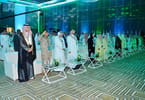Chiang Mai, Thailand (eTN) – Most of the foreign tourists who visit the border town of Mae Sai in northern Thailand come for a visa run. For decades, it has been a normal procedure to reach the scenic bridge over the small Mae Sai River to cross over to Myanmar’s Tachileik, do some shopping on the busy border market, and return to Thailand on the same day with a new visa entry stamp. After the newest visa regulations of the Thai Immigration Bureau in 2009, foreign tourists can do this every 15 days.
But there are other foreign travelers arriving in Mae Sai by bus, car, or motorcycle who really come to see and experience some part of the Union of Myanmar, which is hidden, mysterious, and not easy to reach from inside Myanmar, with its new capital in Nay Pyi Taw. Thus, these foreigners and some Thai domestic travelers use the touring route from Mae Sai to Kyaing Tong, or progress even farther to the Myanmar-China border town of Mong La. On April 29, I arrived in Mae Sai with a friend from Germany and his Cambodian wife at Mae Sai in the evening in order to do just that.
We had left Chiang Mai in the morning at 11:00 hours, remembering to bring along some brand-new passport photos and all our personal belongings for the planned, one-week trip. I was riding in my old Land Rover, which I needed to take across the border to travel independently on my own.
The road to Mae Sai led us out of town on National Highway no. 118, passing Doi Saket and up on the winding road to Doi Nang Kaeo, which is an important watershed between the Ping River in the west and the Mekong River system in the east. Reaching the high mountain pass, there is the old spirit house for Nang Kaeo, also marking the provincial border between Chiang Mai and Chiang Rai.
Further on, we passed the headquarters of Khun Chae National Park and stopped at the famous Hot Spring Spa of Mae Kachan for our first break. We continued to Wiang Pa Pao and Mae Suai, where we had an apple pie and local coffee at the Charin Garden Resort. After that, we hit the National Highway no. 1 at Mae Lao to reach the town of Chiang Rai, which we bypassed to continue to Mae Chan and Mae Sai. We arrived at the border – our final destination – at 17:30 hours after a 245km ride.
Mae Sai is the northernmost spot of the kingdom of Thailand and the large 891-km, marker stone counts from Bangkok in the south. There is an attractive border market around Wat Phra That Doi Wao. Chinese shops and temples abound there.
Accommodations in Mae Sai are reasonable-priced and start from the fancy Wang Thong Hotel ($700 Baht per room) to cheap guest houses along the Mae Sai River for 250 Baht. After having spent one night at Mae Sai, we passed the Thai Immigration border post at 8:00 hours in the morning. To cross with your own vehicle, you have to show your blue car registration book to Thai customs and leave them a copy of it. What is important is that your full name is mentioned in the registration book.
On the Myanmar side of the border, you have to pay your entry permit fee of US$10 per person. All the other needed formalities to continue from Tachileik to Kyaing Tong and Mong La will be handled by the friendly staff of Myanmar Travels and Tours, who are located just beside Myanmar Immigration. There you hand over three passport photos, your passport, and your car registration book. For the Land Rover, I had to pay a car entry fee of US$50 and 1,400 Baht for a local insurance.
Another 100 Baht is needed for the paperwork. In return, you receive your “Entry Permit” from the Immigration Department along with the car entry permit, which is a paper that you have to affix to the front of your car window. Also, you need the original of a road permit for the journey from Tachileik to Kyaing Tong, with some copies for the military checkpoints along the way.
Furthermore, make sure that you have the right pocket money for the trip from Tachileik to Kyaing Tong and Mong La. Actually, you need local money to pay at the road toll gates on the way (6,000Kyat = US$6 for a one-way trip). In Tachileik and Kyaing Tong, you can pay your bills in Thai currency (1000 Baht = 30,000 Kyat), while you need Chinese Yuan (US$1 = 6 Yuan) for Mong La. The best way to change high-valued dollar notes is at the stalls of moneychangers at the Kyaing Tong Market, because there are no banks to use in the whole region.
For the tank of your car, make sure it is filled before leaving Tachileik. It seems that gasoline is a little bit cheaper in Myanmar than in Thailand. We left Tachileik for Kyaing Tong (102 miles away) at 11:00 and drove up to Talay after having passed the first military checkpoint at Mae Yang (Out), where we had a local lunch at a restaurant. From Talay, we continued to Mong Phayak, where the next military checkpoint is located.
The scenery along the way (Asian Highway no. 2) is stunning, with beautiful views in villages, valleys, and on mountain passes. Shortly before reaching Kyaing Tong, there is another military checkpoint at a place called Hot Spa.
Passing the Kyaing Tong Golf Course, you roll into a town, which is similar to Chiang Mai some 50 years ago. It was 16:30 when we reached Kyaing Tong New Hotel in the middle of the town, where a room for foreigners costs US$15 for a single and US$18 for a double room, including breakfast.
After a scenic sunset over the nearby Naung Tong Lake, we walked to the Kyaing Tong Market and had a Chinese dinner at the Lotus Restaurant nearby. The daily Kyaing Tong Market is the economic soul of the city. Early the next morning, we experienced a conglomerate of different tribes and peoples that are not easy to describe. Besides the town population of Shan (Tai Khoen), Indians, and Nepalis, we met some Silver-belt Palaung, Akha, Lahu, and Wa living in the surrounding mountains. It was a shame that the market closes after mid-day, when many of the tribal people have to return to their respective villages.
Interesting to note is that we met the chairman of the local Chamber of Commerce, who was the owner of a gold shop. He reminded us that Myanmar is a very rich country that is not dependent on the outside western world and who is partly boycotting the controversial military government of the Union of Myanmar. The reasons for such a boycott are unclear, especially when comparing Myanmar with other countries around the world. Furthermore, India and China, as well as ASEAN countries like Thailand, make it business as usual with Myanmar and enormously profit out of that.
Kyaing Tong boasts and other tourist attractions, such as the Temple of the Mahamyatmuni Buddha Image (Wat Pra Sao Loang). This highly-venerated Buddha Image is a replica of the famous Mahamuni Buddha of the Arakan Pagoda in Mandalay, whose legendary history goes back to the time of the Buddha.
The Buddha Image of Kyaing Tong was cast in Mandalay in 1921 and consists of a mixture of pure gold, silver, and copper. Its princely appearance is overwhelming, and it has been transported with great difficulty from Mandalay to Kyaing Tong by crossing the mighty Salawin River, which divides Shan State into two parts. The capital of Shan State today is Taunggyi, but it is not possible for tourists to travel by road from Kyaing Tong further west because of security reasons.
After another quiet night in Kyaing Tong, we left early the next morning to Mong La (54 miles away) towards the Chinese borderland in the northeast. For that, we had to acquire another road permit from the local immigration officer stationed at Kyaing Tong. The road (Asian Highway no. 3) went over high mountain passes, in between the military checkpoint of Ta Pin. As we stopped there during lunchtime, we were invited for a real Burmese meal without paying anything.
Along the way, we went through Tai Khoen and Lahu mountain villages. As the engine of my Land Rover got overheated, we lost oil and water and had to refill. The last stretch of the road to the checkpoint of Special Region 4, administered by the Wa ethnic group, was rocky, and we received help from a Burmese bus driver, who pulled us through. At the Wa checkpoint, we had to pay 36 Chinese Yuan per person as an entry fee.
It was shortly before nightfall, and we needed a break. The whole action had been too much for the Land Rover (from 1974) and we had to rely on the service of a taxi driver (for 250 Yuan). He pulled us more than an hour from the Wa checkpoint to our destination Mong La and dropped us near a local repair shop. We checked in at the nearby Ba Lai Hotel at 22:30 hours (for 70 Yuan per room).
Mong La is in the center of a special economic zone. Everything seems possible, and there are a myriad of new hotels, restaurants, shopping centers, Internet facilities, casinos, and discos. Chinese people dominate in an area where Tai Lue villages abound. But the nearby border checkpoint of Daluo in Sipsongpanna is within China’s Yunnan Province and cannot be crossed by individual foreign tourists.
I spent the whole next morning trying to arrange the repair of the Land Rover, which swallowed another 200 Yuan, but it was more than worth it. In the afternoon, we could drive again, and we visited the local Drugs and Gems Museums. On a hill just before the Myanmar-China border, there is the spectacular Dwaynagara Shwe Pagoda where you can learn more about Burmese Buddhism. Also nearby is the Roman Catholic Church of St. Mary, and mosques exist in all the visited places along the old caravan trail from Chiang Mai to China. Except for the Muslim restaurants, you can get Myanmar Beer everywhere, which has a good taste and quality.
Early in the morning on May 4, we left Mong La to head back to Kyaing Tong, going the same way we had come before. After getting a new road permit from the local immigration officer for the Mong La-Kyaing Tong leg, we were greeted with the utmost friendliness, and everywhere the people were familiar with us.
We checked in again at the Kyaing Tong New Hotel for another night and witnessed a colorful parade of boys who were to become novices throughout the town. Young girls and elder women carried flowers and money trees along bamboo poles. Music created by gongs and drums was in the air.
When night fell, a huge 22-meter high and new Standing Buddha Statue was illuminated – pointing to the centrally located lake, creating an atmosphere like paradise lost.
To make a long story short, we departed Kyaing Tong at 9:00 the next morning, after again getting the road permit from Kyaing Tong and Tachileik at the local immigration office. This time we had our local lunch at Mong Phayak and continued to Talay in the sunny afternoon. Arriving at Mae Yang (In) and then at Tachileik at 17:00 hours, we checked in at the Dream Flower Guesthouse (for 400 Baht per room). We even entered a new and modern Internet shop, which is the first in Tachileik and run by a Chinese businessman. Also, Tachileik is boasting a replica of the Golden Shwedagon Pagoda and – as the “City of the Golden Triangle” – is becoming more and more important.
When we left Myanmar the next morning at 8:30 hours, we crossed over the Mae Sai Bridge. We got our passports back, and I received my car registration book. At the Thai Immigration, we got our passports stamped for a 15-day stay. This is actually the same period that we could have been staying in Shan-State with our special entry permit from Myanmar.
Finally, our way back to Chiang Mai led through the hilly landscapes of Mae Chan, Mae Ai (Tha Ton), Fang, Chiang Dao, Mae Taeng and Mae Rim. When we reached Chiang Mai at 18:30 hours, we were glad to have made it and will remember the Union of Myanmar from one of its best sides.
For further information, please contact GMS Media Travel Consultant Reinhard Hohler by email: [email protected].
WHAT TO TAKE AWAY FROM THIS ARTICLE:
- For decades, it has been a normal procedure to reach the scenic bridge over the small Mae Sai River to cross over to Myanmar's Tachileik, do some shopping on the busy border market, and return to Thailand on the same day with a new visa entry stamp.
- 118, passing Doi Saket and up on the winding road to Doi Nang Kaeo, which is an important watershed between the Ping River in the west and the Mekong River system in the east.
- On April 29, I arrived in Mae Sai with a friend from Germany and his Cambodian wife at Mae Sai in the evening in order to do just that.






















